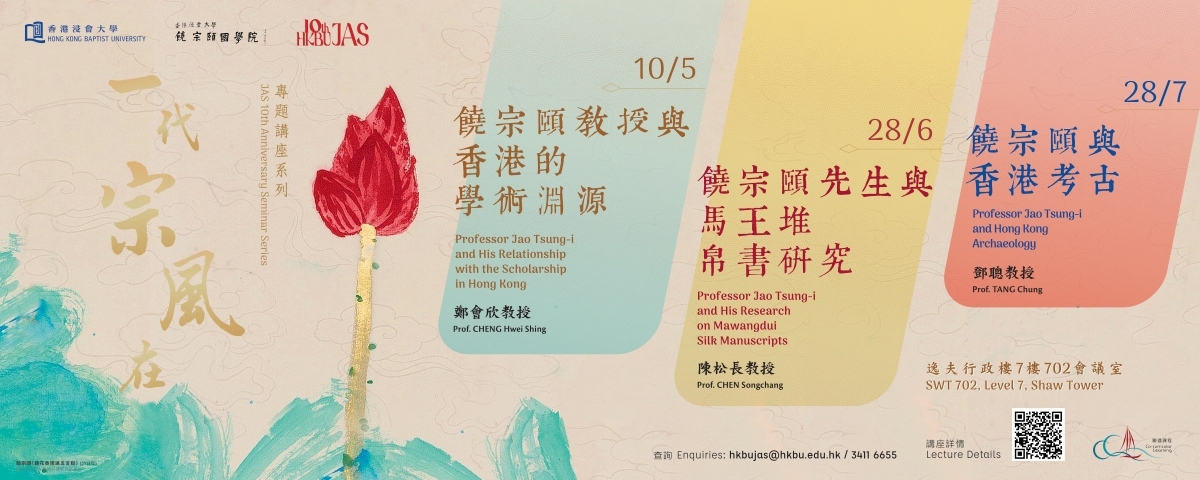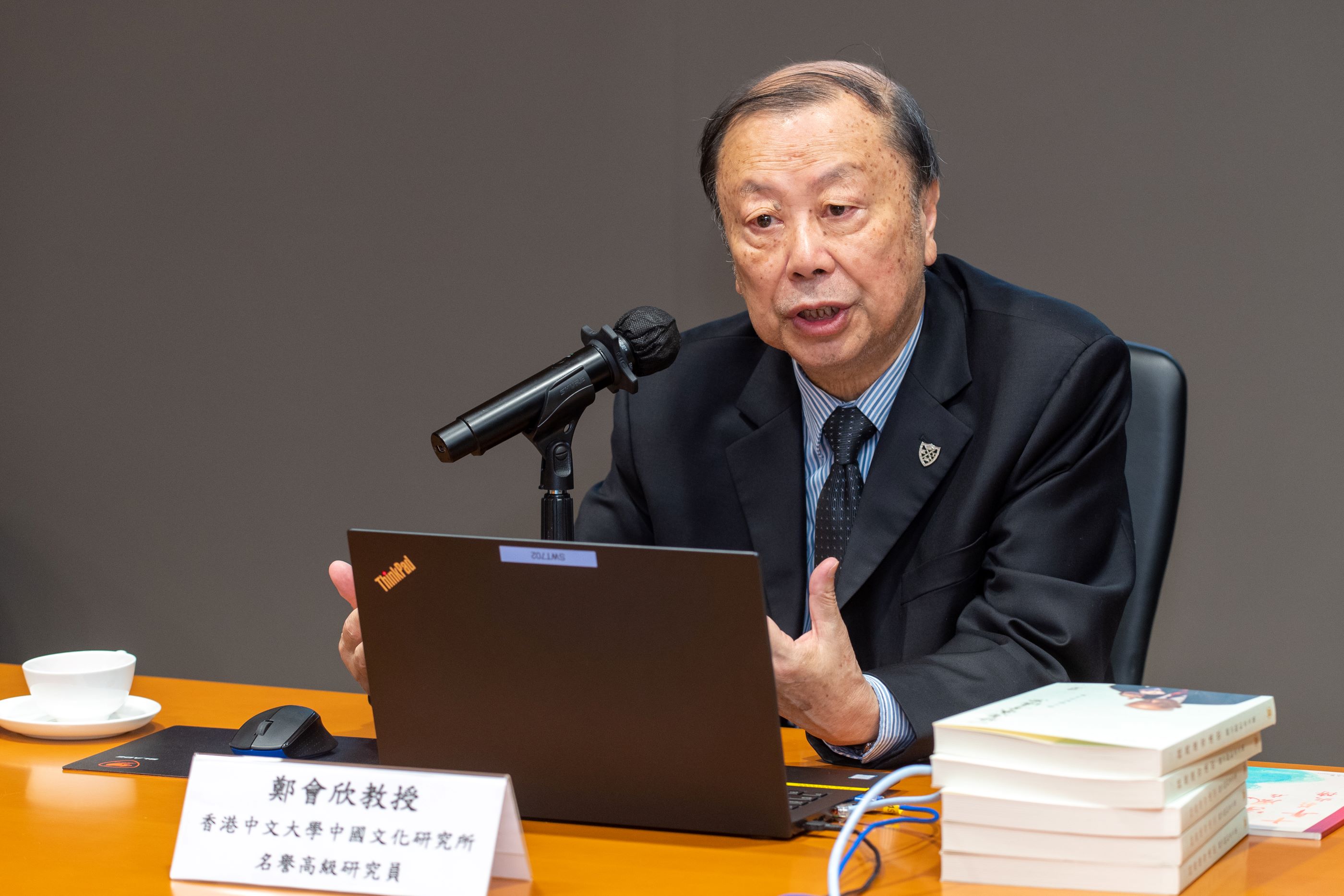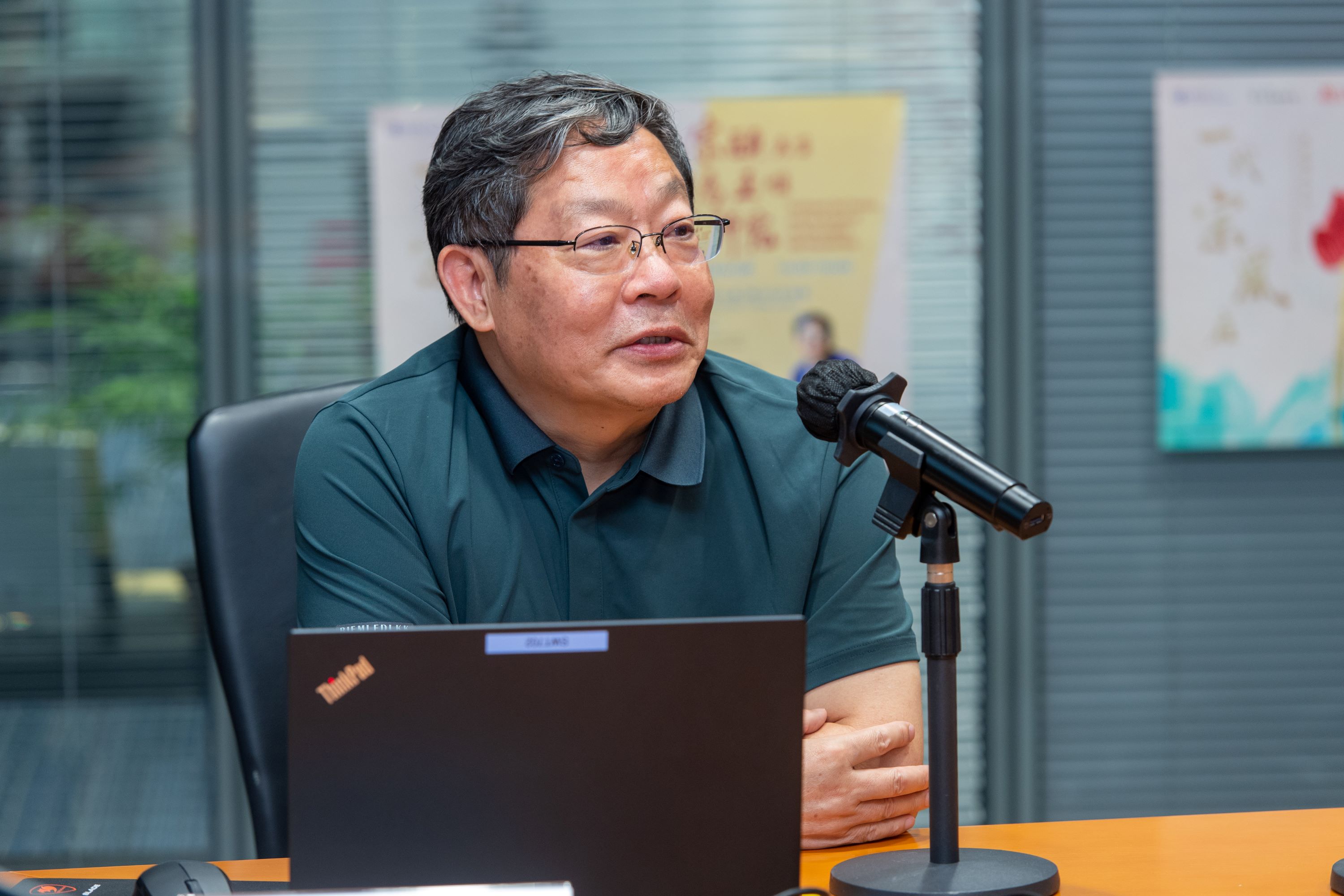Celebratory events 2023
JAS 10th Anniversary Seminar Series




2023 marks the tenth anniversary of the founding of the Jao Tsung-I Academy of Sinology and is also the fifth year after the death of Master Jao himself. In cherishing the memory of the titanic talent of this master craftsman of scholarship, the Academy has instituted a special plan to put on a series of 6 public lectures. The series is split into two: its first part is a mini-series themed ‘For a Generation, the Ancestral Spirit Resides’, its aim being to stimulate the public to deepen their understanding of Professor Jao Tsung-i’s pioneering energy and inspirational contribution to Classical Chinese Studies, Sinology, and other related fields; it also includes scope for the compilation, editing, and publishing of relevant monographs, research, and achievements of recent students in the field of Jao Studies; its second part is a lecture series themed ‘For Ten Years, the Torch is Passed’ in which Xuantang doctoral graduates or researchers who have worked at the Academy will be invited to set forth their most recent research findings to underpin the significance to scholars of inheriting the past to open up the future and passing the torch down the generations. In this way, the fiery essence of Master Jao’s scholarly wisdom will, in its transmission, continue burning and remain unextinguished, passed down by generation after generation. Below are three lectures that the Academy has already put on as part of the mini-series themed ‘For a Generation, the Ancestral Spirit Resides’.
Professor Jao Tsung-i and His Relationship with the Scholarship in Hong Kong 2023/5/10
Professor Cheng Hwei Shing
Honorary Senior Research Fellow, Institute of Chinese Studies, Chinese University of Hong Kong
Professor, Department of History, Chinese University of Hong Kong; (concurrently) Professor, Department of Chinese Culture, Hong Kong Polytechnic University


Graduated in History Major from University, Professor Zheng began by reminiscing when, in early 1990 and fresh in his first academic appointment, he was given a post, after an interview, as Professor Jao’s assistant, and this was something that he had never thought possible—to come so close to this titan of the scholarly world. Many people erroneously think that it was in 1949 and stimulated by writing a sequel to Chaozhou zhi (Chaozhou annals) that Master Jao first came to Hong Kong, but Professor Zheng heard directly from Master Jao himself that the first time he had fulfilled his destiny and come to the territory was two years after the outbreak of the war of resistance against Japan. At that time, Master Jao had been appointed as a research fellow at the National Sun Yat-Sen University, which had been forced by the conflict to evacuate to Yunnan. On the journey to get there and take up his post, he had intended to pass through Hong Kong, but owing to contracting an illness, he ended up staying for a while.
In 1949, Master Jao came to Hong Kong once more, and the devastation of war was still all around. He listened to Fang Jiren’s opinion and remained in Hong Kong. In fact, it was owing to Fang’s inspired foresight that Hong Kong was able to give shelter to a young man who proved to be the outstanding historian and wordsmith of his generation. Fang Jiren could be regarded as the first noble benefactor of Master Jao’s career. Another person who should be counted as extremely influential on Master Jao was Professor Frederick Drake. In 1952, Professor Jao was appointed by Professor Drake as a special lecturer in the School of Chinese of Hong Kong University, which proved to be a pivotal moment in his scholarly career. After this, Master Jao not only received the financial support of the University but was also able to attend scholarly meetings all over the globe and take on roles as a visiting scholar. With the support of Professor Drake, he was also awarded grants by the Harvard-Yenching Institute and after many years of hard work assembling a wealth of material, penned the book Yindai zhenbu renwu tongkao (A comprehensive examination of Yin dynasty diviners) and had it published. Owing to this, he was able to establish himself as a leading light in research into oracle bone texts.
Finally, Professor Zheng summarised with the eyes of a historian how the uniquely abundant cultural conditions of Hong Kong furnished Master Jao with fertile intellectual soil from which he was able to reap outstanding scholarly achievements. In his later years, Master Jao put in great efforts to nurture future generations of scholars and give as much back to society as he could. This embodied the morality and justice of a noble spirit that seemed to hold the whole world in his breast and sought to the upmost to implement benevolence and virtuous morality. Master Jao’s scholarly enthusiasm and unflagging spirit similarly succeeded in infecting and inspiring every member of the audience present.
Professor Jao Tsung-i and his Research on Mawangdui Silk Manuscripts 2023/6/28
Professor Chen Songchang
Yuelu Academy, Hunan University


In this lecture, Professor Chen Songchang reminisced on precious time spent in interaction with Master Jao and outlined five aspects of Professor Jao’s unique views on the Mawangdui books on silk. Firstly, Master Jao’s investigation of the linguistic collocation taiheng太恆 (ultimate eternity) in Zhouyi (The Zhou dynasty book of changes) is one of his most representative research achievements. He indicates that when this expression is used in the silk manuscripts, it carries in fact the same meaning and is interchangeable with the taiji 太極 (ultimate extremity) employed in modern redactions. The customary usage of the character heng 恆 embodies its unique position inside studies on Chu culture. These views resonate with those of Qiu Xigui. Secondly, Master Jao’s interpretation of the names of deities in the ‘Jiugongtu’ (Nine halls diagram) of the silk manuscript Xing De (Punishments and virtuousness) is even more ingenious. He demonstrates, for example, that Tuanwang 湍王 is in fact Zhuanxu 顓頊, and likewise that nieshi 聶氏 is sheti 攝提. All these points have achieved wide acceptance across the globe as authoritative, which reveals the breadth of his learning and penetrative investigative powers.
Thirdly, Master Jao took the silk manuscript Tianyi tu 天意圖 (Heavenly Unity diagram) as a point of departure and discussed in detail the similarities and differences between Tianyi 天一 (Heavenly Unity) and Taiyi 太一 (Supreme Unity) and the changes in their status. This was an extremely significant contribution to exegesis of documents of the type that dealt with the numerological arts and has proved to be some of the most individual of his research. Fourthly, Master Jao used the silk manuscript Taiyi jiang xing tu (Drawing of the Procession before the Departure of the Supreme Unity) and ‘Yuan you’ (Distant journey) of the Chuci (The ci poems of Chu) as mutually corroborating evidence and thus fused together research into history, literature, and iconography etc. From this, the immense efforts that he put into comparative reading and mutual corroboration between transmitted and excavated texts can be appreciated. Fifthly, Master Jao considered that from examining the calligraphic forms of the Mawangdui manuscripts such as Laozi and Zhouyi, the clerical script (lishu) of the Han dynasty is found to have already reached its maturity. He was also unequivocal in his opinion that study of excavated bamboo and silk manuscripts should be elevated to a status equal to that of study of inscriptions on steles and of the calligraphy on paper and silk, and the three form a tripartite relationship.
Finally, Professor Chen Songchang concluded that Master Jao’s research on Mawangdui manuscripts emphasised three areas in particular: canonic texts and classical writings, documents on the numerological arts, and diagrams and calligraphy. Professor Chen sighed with admiration that Master Jao’s scholarly prowess was not only grounded in the unified excellence of the myriad schools, but also opened up unique perspectives in many disciplines, acting as an inspiration to his fellow scholars as well as providing splendid benefit to the scholarly community.
Lecture video:HKBUTube, Bilibili
Professor Jao Tsung-i and Hong Kong Archaeology 2023/7/28
Professor Tang Chung
Institute of Cultural Heritage, Shandong University


For this lecture, the well-known Hong Kong archaeologist Professor Tang Chung was invited to introduce the important contribution that Professor Jao Tsung-i made to the development of archaeology in Hong Kong itself and how this has allowed the seven thousand illustrious years of the ancient culture of Hong Kong to reappear before our eyes.
Professor Deng first recalled his contact with Master Jao during his years of study and working at the Chinese University of Hong Kong and remarked directly that he regarded him as his mentor. He then outlined in succession three immense contributions that Master Jao had made to archaeological work in Hong Kong. These were: investigation and verification of the dating of the Lee Cheng Uk brick-chambered tomb, evaluation of the Song dynasty Guanfuchang salt-fields and Xianchun era cliff inscriptions composed and inscribed by Yan Yizhang, and an important breakthrough in research into jade blades (yazhang) of the Xia and Shang dynasties as well as into the Doubting Antiquity School. The first two of these reflect Master Jao’s incisive views on Han and Song dynasty archaeology. Following detailed investigation of text, bronze implements, and other items from the Lee Cheng Uk tomb, Master Jao was able to prove that the tomb dated to the Eastern Han dynasty and that it had extremely close connections to other Han tombs in the Pearl River Delta region. The discovery of the Song dynasty Xianchun era stone inscriptions inscribed by Yan Yizhang furnished rich material for Master Jao to analyse the relationship between the history of the Kowloon peninsula and the final phase of the Song dynasty empire, and the influence of this research remains strong to this day. The third stems from his research into jade blades of Tai Wan on Lamma Island. Professor Tang narrated his personal experience of taking part in the 1990 archaeological investigations at the Tai Wan site and vividly described the astonishments of real-time excavations. After the discovery of the jade blades at Tai Wan, Master Jao took the lead in promoting the convening of an international scholarly conference related to this and made a keynote speech ‘Jade blades and the Expansion of Ancient Territory’. This triggered recollections of Master Jao’s scholarly differences with the historian Gu Jiegang in the early years that had prompted his abandonment of editorial work on Gushi bian (Debates in ancient history). The evidence of excavation of Shang dynasty jade blades in Hong Kong, Vietnam, and elsewhere has since vindicated Master Jao’s scholarly viewpoint of an ‘expansion of ancient territory’.
While respecting his teachers and inheriting the scholarly energy of earlier excellence, Master Jao was nonetheless able to maintain his own independence of thought and did not blindly drift in the stream, and this is certainly worth of emulation. In addition, the attention that Master Jao paid to archaeological fieldwork is rare among Hong Kong scholars. He emphasised that it was only through excavated discoveries that the China preserved underground might be viewed, and a reconstruction of ancient history in this way could take on a new direction.
Lecture video:HKBUTube